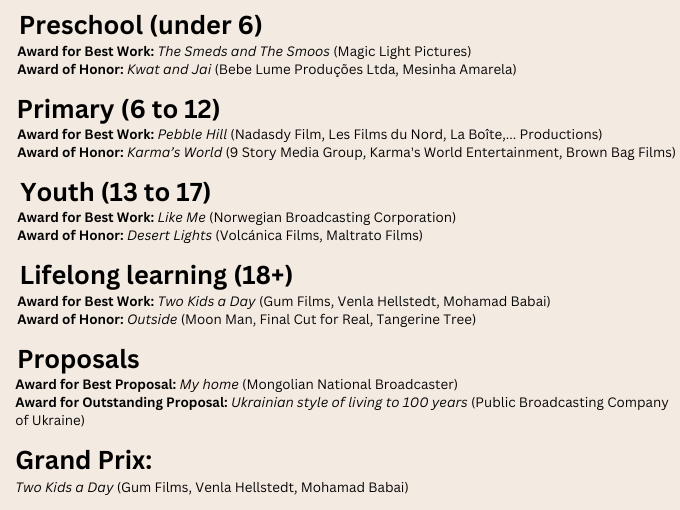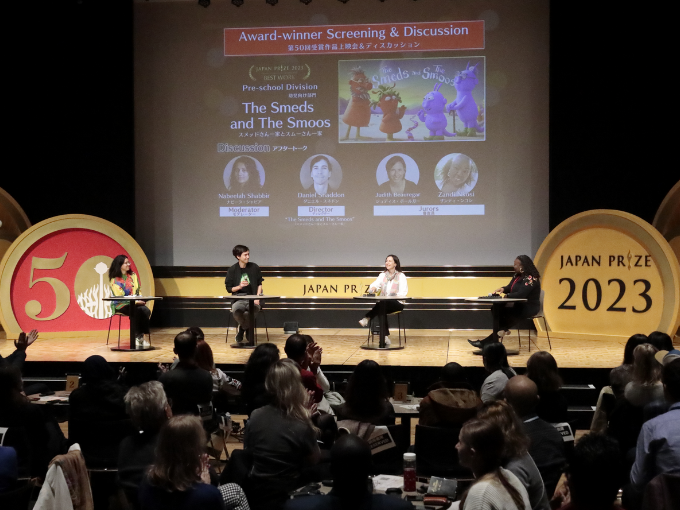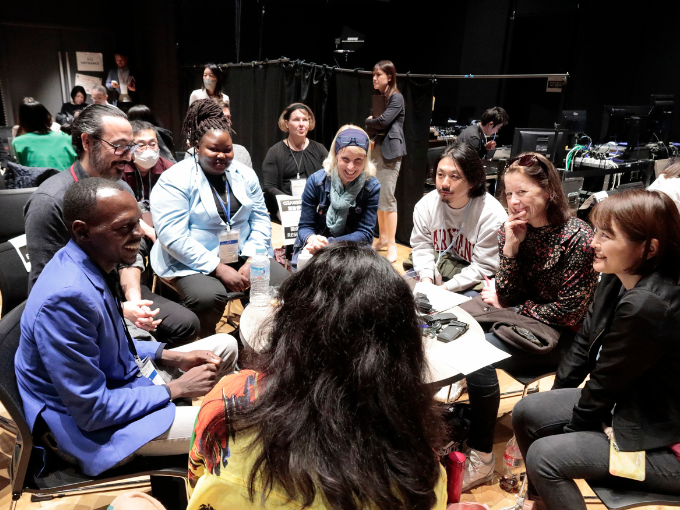Classic preschool show Teletubbies. 1960s’ Swiss series The Life of Our Insects. The 2020 climate activist documentary I Am Greta. What do these projects have in common?
They are all past winners of the Japan Prize, an international competition for creative educational programming that just turned 50 in November.
Orchestrated by Japan’s public broadcaster NHK, the program has a uniquely diverse legacy that stands at the crossroads of learning and entertainment. And its 2023 program attracted 391 submissions from 55 countries, a testament to its wide-reaching popularity.

The winner and runner-up (also known as the Award of Honor) in each category of the 50th Japan Prize.
“The 2023 finalists in preschool and primary ranged from big-budget animated specials and series, to independent creator-driven films about indigenous culture, migration and more,” says David Kleeman, SVP of global trends at Dubit and a three-time Japan Prize juror.
Kleeman offers strong praise for all of last year’s winners, adding that his personal favorite was preschool runner-up Kwat and Jai. This animated/live-action series from Brazil’s Bebe Lume spotlights indigenous culture with a story about two twins who journey to the haven of their community in search of their mother. “While the life of the tribe is very different from what most kids experience, there are enough ‘handholds’ or familiar elements that they won’t be put off or confused, but will instead find empathy and connection.”
One of the prominent themes that emerged during last year’s 50th edition was foresight. With the metaphor of pruning a tree, Kleeman underlines that the Japan Prize continually helps shape the future of kids media. “You support the strongest branches—themes, ideas, approaches and people—in the hope that they will keep growing.”
HOW IT WORKS
An organizing committee called the Japan Prize Secretariat is responsible for overseeing the competition. Leading the way in this bustling process is Shin Yasuda, who has been Secretary General of the Japan Prize since 2021. He has worked at the NHK for more than 25 years, starting out as a producer and eventually heading up international co-productions.
Evidently, the Japan Prize follows a motto that you are never too young or too old to expand your understanding of the world. This ethos has shaped its four main audio-visual categories: preschool (under six), primary (six to 12), youth (13 to 17) and lifelong learning (18-plus). Separately, there is also the coveted Grand Prix, which goes to the most outstanding project from among the four audio-visual winners—essentially honoring the best of the best.
The competition also includes the Proposal Pitch, a relatively new category that was introduced in 2003. With this award, the NHK gives financial support to a pair of projects in development from regions with limited budgets or technical facilities. The jurors will pick one winner to receive US$10,000, and a runner-up gets US$6,000.
The Japan Prize Festival is a November live event that runs over three or four days in Tokyo’s fashionable Harajuku district. All nominees are historically invited to attend (with the NHK covering travel costs for one producer/director for every nominated project), and the winners are announced in person.
But for last year’s 50th edition, the Japan Prize tried something new, announcing the winners in each of the four main categories in advance, and using the event to unveil just the Grand Prix winner.
JUDGING PROCESS
Judges assess entries on production value but also on educational value, with the intention of giving small-scale or resource-scarce producers a fair opportunity. “The jurors look at whether the entry challenges the target audience’s assumptions and preconceptions,” Yasuda explains. And “target audience” can be anything from an all-encompassing group like global youth, to a very specific niche like preschoolers in Namibia.

Discussions on stage following the screening of preschool category winner ‘The Smeds and The Smoos’ from the UK’s Magic Light Pictures.
To make sure that different viewpoints are represented in the rigorous judging rounds, the committee carefully selects jurors from an ever-growing network of multinational professionals comprising producers, distributors, journalists, educators and broadcasters.
Yasuda stresses that jury deliberations are always encouraged to focus on qualitative assessment through group discussion, rather than simply tallying numbers from scorecards. There are two sets involved—20 jurors handle the preliminary rounds (determining the nominees for the four main categories) and 12 jurors oversee the final round (choosing the winner and runner-up from each category).
In the months leading up to the in-person event, the committee hosts online video calls with the preliminary judges, who spend long hours debating and “exchanging ideas about what they think is good about the entries,” Yasuda notes. “We think it’s important to discuss questions, like what would be a [defining] topic for a certain year, or what is relevant for the target age group.”
Martina Pestaj, head of children’s and youth at RTV Slovenia, was a final juror in 2023. And the experience culminated in a thrilling online debate. “We were united until third place, and then spent almost two hours deciding between the final two,” she recalls. “When we met live in Tokyo at the festival, we all had the feeling that we knew each other well, and had a big common story behind us—that really connected us.”
HISTORY AND ORIGINS
Following years of internal interest, the NHK launched the Japan Prize in 1965, and the competition was originally designed for two types of media only: television and radio.
Yasuda says that in this unique post-WWII era, a lot of countries began to see opportunity in the TV medium beyond just entertainment value. “Japan was devastated by the war, as were a lot of nations around the world,” he says. “So there was [more] motivation and incentive for producers to come up with creative content to educate the public.”
At this time, the NHK itself was still relatively young—it began broadcasting in 1953, and only launched its second channel (with an educational focus) in 1959. “So we were [still] exploring and trying to figure out what kinds of programs were suitable for young children, as well as for adults for lifelong learning.”
The first-ever Grand Prix winner was a black-and-white film called The Calendar of Nature from YLE in Finland. This experimental pic had no spoken dialogue, and instead showed a group of kids peacefully playing outdoors until they’re suddenly interrupted by trucks arriving to convert the playground into a corporate facility.
Yasuda says the project evoked a lot of debate among jury members, who went back and forth on whether it qualified as having educational value. “Ultimately, the film posed some interesting questions, specifically because it had no narration or host. It’s a very poetic montage of children in nature as they hear the footsteps of industrialization,” he observes. This rather unconventional choice helped set the ethos of the Japan Prize right away as a competition that thinks outside the box and considers a broad definition of educational content.
IMPACT ON CONTENT
The competition strives to highlight relevant topics that are reflective of the changing times and generational challenges. Occasionally, it has even been avant-garde, says Yasuda, referencing the strong environmental themes of the 1965 winner. “People weren’t discussing environmental destruction then, so it was actually quite foretelling.”
In a more recent example that speaks to today’s Gen Alpha digital natives, the 2018 Grand Prix went to a kids documentary special Born To Vlog from Blakeway North in the UK. It follows Nikki Lilly, a 12-year-old girl with a blood vessel disorder who becomes a vlogging sensation. The personal story also weaves in educational value in the form of kid-friendly tips for safely using the internet and dealing with online bullying.
The Japan Prize has also played an important role in kids media history by facilitating international market expansion for some shows. Sesame Street notably won the Grand Prix in 1971, just two short years after it debuted in 1969. But an interesting fact is that the win was part of the reason why the show was acquired by NHK, and thus introduced to Japanese audiences.

Attendees of last year’s Japan Prize Festival have a conversation after a screening of a winning project.
Kleeman attests to the significance of the Japan Prize, noting how it efficiently navigates a common hurdle in many children’s media competitions. Sometimes, judging panels wind up comparing apples to oranges when the entries range too widely in format, budget and even cultural background. “[But] with Japan Prize debates, we always return to the central touchstone of what the creators set out to convey to the audience, and [whether] their choices and execution are successful in achieving those goals.”
It’s also worth entering for the increased exposure and awareness, even if a project doesn’t end up winning. For instance, Yasuda recalls how Australian teen drama First Day (about a transgender girl’s experience at school) left a strong impression on all the jurors—so much so that the show’s producers were invited to speak on a diversity panel at the Japan Prize and share their research and creative process insights. The NHK even picked up two seasons of the show, which Yasuda says has performed well on the network.
EVOLUTION AND FUTURE
The overall focus and criteria for the Japan Prize has remained largely unchanged, barring a few different names used over the years for various prizes. But one significant shift took place when the committee introduced a new category in 2008 dedicated to digital media, which had evolved from a web division launched in 2002. With this expansion, games, online shorts and mobile apps became eligible for the competition.
And in yet another evolutionary step forward last year, digital content now competes in the main four categories alongside traditional audio-visual media. A good example from 2023 is The Contraception Guide—a TikTok series from Norway centered around reproductive health awareness for teens that was nominated in the Youth category.
Kleeman is hoping to see more digital entries in the future for the kids and teen categories. “It’s important for the competition to reflect the distinct and unique ways in which all forms of media contribute to young people’s learning today.”
The Japan Prize doesn’t charge a submission fee or participation fee for those who are interested in attending the ceremony in November. “If you can travel to Japan, it’s a great place to [network with] filmmakers from all around the world,” says Yasuda.
For first-timers who want to submit a TV series, Yasuda recommends choosing an episode that can work well as a standalone, since some of the jurors may not be familiar with the full arc of the show. He is also eager to see more small-scale projects enter the race. “It doesn’t necessarily have to be glossy or have high production value. If it’s had a huge impact on your community, it will definitely be looked at.”
This year’s edition of the competition will open for entries on March 1 and close on June 6. More information on submission guidelines are available on the NHK’s Japan Prize website.






















